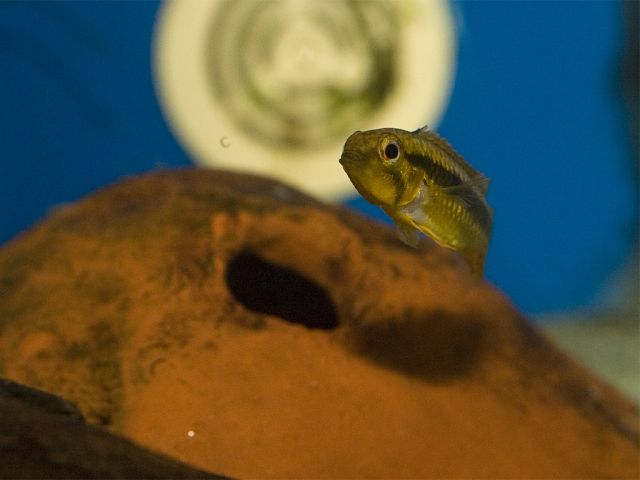- Messages
- 11,230
- Location
- Denver, Colorado, U.S.A.
I just had the strangest thing happen for me. I have 2 tanks with A. sp. Abacaxis/Wilhelmi. In one tank the female was added about 1½ weeks ago. This tank already had a male Abacaxis & a female A. sp. Miuá. I partitioned off part of the tank for the Abacaxis female so that she could adjust to her new surroundings before introducing her to her tank mates. Last week I removed the partition. The MiuÂá female immediately attacked the Abacaxis female, but the male Abacaxis always swam between them, keeping them apart. That seemed promising to me.
Last Friday the female Abacaxis suddenly turned bright yellow & started driving the other 2 fish into a heavily planted part of the tank, but she almost never entered a cave. I wasn't sure if she spawned or not, but I she certainly wasn't fanning eggs by being out in the open all of the time.
Last Sunday, I discovered a female in my other tank that was guarding 50+ eggs. I immediately added a partition to separate her from her male & the other female Abacaxis in the tank. She remained a grayish-yellow color while staying in the breeding cave. Today the eggs hatched, but the female is not in the cave with the wigglers! Just like the female in the other tank, she has turned bright yellow and stays outside the breeding cave most of the time. In the other tank, my other female appeared with a swarm of over 50 tiny fry - almost as small as dwarf Laetacara fry. Right now I am feeding the fry with APR and newly hatched brine shrimp. It seems that they do not stay with the wigglers very much. Has anyone else seen such odd behavior in this species?
Last Friday the female Abacaxis suddenly turned bright yellow & started driving the other 2 fish into a heavily planted part of the tank, but she almost never entered a cave. I wasn't sure if she spawned or not, but I she certainly wasn't fanning eggs by being out in the open all of the time.
Last Sunday, I discovered a female in my other tank that was guarding 50+ eggs. I immediately added a partition to separate her from her male & the other female Abacaxis in the tank. She remained a grayish-yellow color while staying in the breeding cave. Today the eggs hatched, but the female is not in the cave with the wigglers! Just like the female in the other tank, she has turned bright yellow and stays outside the breeding cave most of the time. In the other tank, my other female appeared with a swarm of over 50 tiny fry - almost as small as dwarf Laetacara fry. Right now I am feeding the fry with APR and newly hatched brine shrimp. It seems that they do not stay with the wigglers very much. Has anyone else seen such odd behavior in this species?
